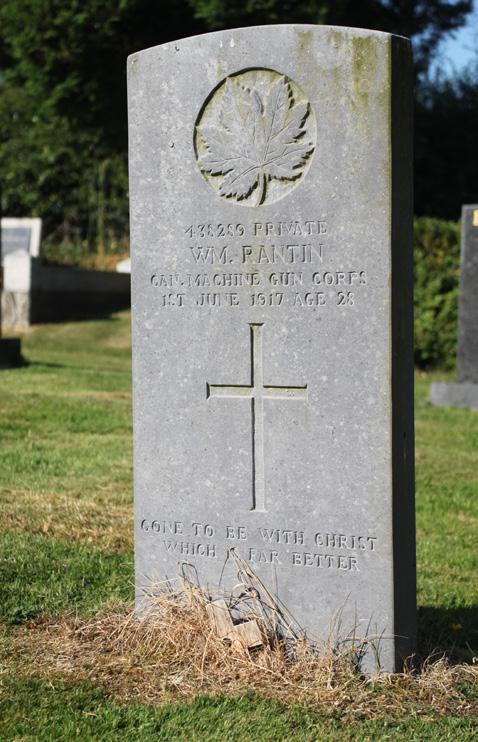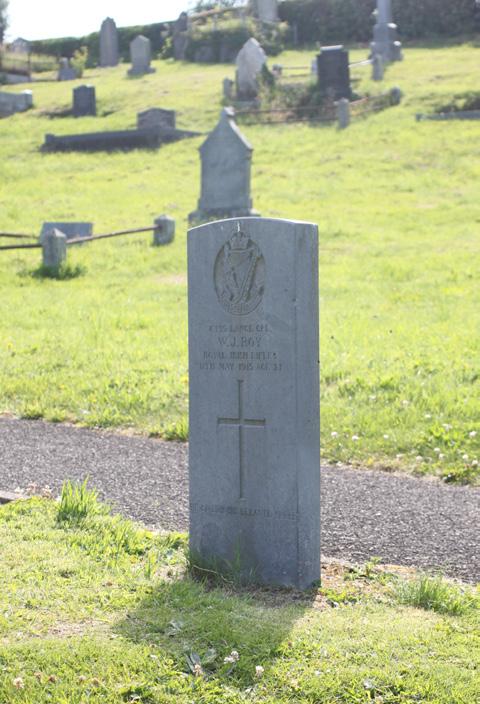
3 minute read
Poyntzpass
from A Guide to First World War Commonwealth War Graves in Newry & Mournehe title of your publication
by VisitMourne
Grave of Claude Ballard (Newry and Mourne Museum Collection)
ACTON CHURCH OF IRELAND, POYNTZPASS
Private James W. Templeton
James Templeton was born in Belfast and was the only child of Robert (a farmer) and Margaret Templeton, Newry (formerly of Poyntzpass). He had been a law clerk, working with Newry solicitor, William Johnston, for about seven years before he joined up in September 1915. He was in the Army Ordnance Corps and had been on active service in France for about a year before his death. He was 5 foot, 8 inches tall, had blue eyes and fair hair. At Grove Town, France, in March 1917, he contracted tuberculosis as a result of “active service (exposure & infection)” and originally was cared for in a French military hospital. About a fortnight before his death, which occurred on 10 May 1917, he was admitted to the Third London General Hospital, Wandsworth, and it was there that he died at the age of 23. He was given a military funeral, with his remains leaving from his mother’s residence in Sandys Street, Newry and making their way to the family burying ground at Acton Church of Ireland, Poyntzpass.
POYNTZPASS PRESBYTERIAN CHURCH
Rifleman John Croft
John Croft of Poyntzpass was a rifleman in the Royal Irish Rifles. He died on 23 June 1920 at the age of 36. He is buried in Poyntzpass Presbyterian Church and was survived by his wife, Jane.
Grave of John Croft
ST JOSEPH’S ROMAN CATHOLIC CHURCH, POYNTZPASS
Private John Campbell
John Campbell was the son of Henry and Annie Campbell of Drumbanagher. At the outbreak of the First World War, John joined the Royal Irish Fusiliers and after undergoing some training was sent to France, where he served until he received a severe wound early in 1917. He was then invalided to England and discharged on 8 November 1917. Since that time he had been in an ailing condition. His prolonged illness ended in his death on 9 January 1920. He was 21 years of age. Rev. Fr. Quinn, Bessbrook, officiated at the funeral which was attended by “the general public of all creeds” and the demobilised sailors and soldiers of the district.

WARRENPOINT
CLONALLAN CHURCH OF IRELAND, WARRENPOINT
Lieutenant John Forster Elliott, M.D.
Dr Elliott, born on 9 June 1867 at Townsend Street, Parsonstown, Westmeath, was the son of John Forster Eliott (a bank manager) and Hester Charlotte McComb Elliott. He studied medicine at Trinity College, Dublin, and the Ledwich and Carmichael Schools of Medicine there. Dr Elliott was a surgeon with the Union Steamship Company before setting up as a general practitioner in Manchester in the mid-1890s. Around 1900 he went to Natal (South Africa), where he held the post of medical officer to the Indian Immigration Board. Returning home a decade later, Dr Elliott started practice at Rostrevor. A staunch Unionist, in the pre-war days he was actively involved with the U.V.F. movement and was in charge of the local ambulance section. In September 1916, when an appeal was made for qualified medical men, he joined the Royal Army Medal Corps as a (temporary) Lieutenant. He gave him his house in Rostrevor and his wife went to live with her elderly and disabled mother, Mrs Reid and unmarried sister, Miss Edith Reid, who resided at Victoria Square, Rostrevor with a live-in domestic servant, Kathleen Trainor. Lieutenant Elliott was sent to Lathom Park, near Ormskirk, Liverpool, where there was a hospital for wounded soldiers. The sights and scenes he witnessed in the hospital had a profound impact on Dr Elliott and he was sent home on sick leave in September 1917. His sister-in-law recounted how upon his return he was thinner, “not as bright as usual”, and was suffering from depression and sleeplessness. He died on 30 September 1917 at Rostrevor and the jury at the subsequent inquest returned a verdict of “suicide during temporary insanity”. In sympathizing with Dr Elliott’s wife (Mrs Norah Nugent Elliott) and family, the local newspaper described “poor Dr. Elliott” as “another victim to the horror war”.









